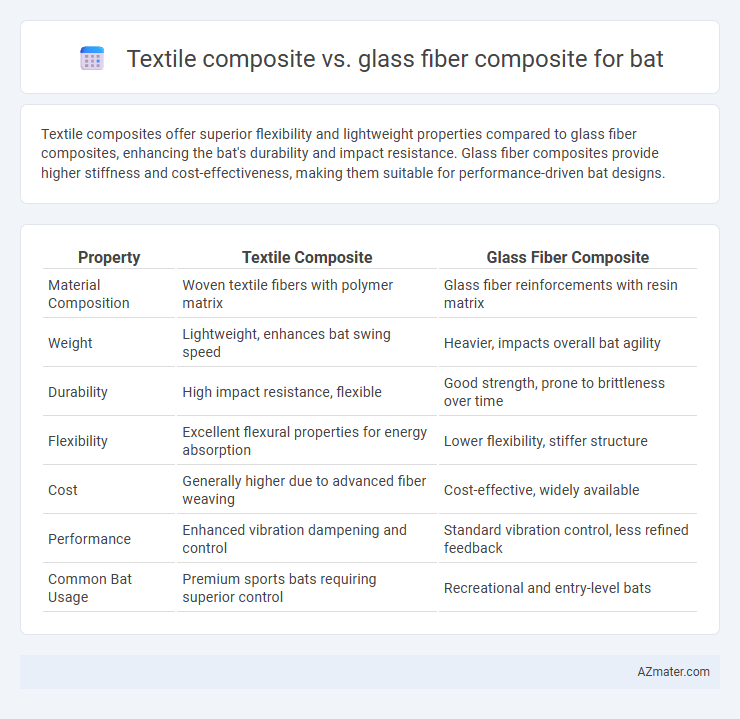Textile composites offer superior flexibility and lightweight properties compared to glass fiber composites, enhancing the bat's durability and impact resistance. Glass fiber composites provide higher stiffness and cost-effectiveness, making them suitable for performance-driven bat designs.
Table of Comparison
| Property | Textile Composite | Glass Fiber Composite |
|---|---|---|
| Material Composition | Woven textile fibers with polymer matrix | Glass fiber reinforcements with resin matrix |
| Weight | Lightweight, enhances bat swing speed | Heavier, impacts overall bat agility |
| Durability | High impact resistance, flexible | Good strength, prone to brittleness over time |
| Flexibility | Excellent flexural properties for energy absorption | Lower flexibility, stiffer structure |
| Cost | Generally higher due to advanced fiber weaving | Cost-effective, widely available |
| Performance | Enhanced vibration dampening and control | Standard vibration control, less refined feedback |
| Common Bat Usage | Premium sports bats requiring superior control | Recreational and entry-level bats |
Introduction to Composite Materials in Bat Manufacturing
Textile composites in bat manufacturing utilize woven fibers embedded in resin matrices, offering enhanced flexibility and impact resistance compared to traditional glass fiber composites, which provide higher stiffness and strength due to their silica-based fiber structure. The selection between textile and glass fiber composites directly influences bat performance, durability, and weight, with textile composites enabling better energy absorption during ball impact. Advances in composite materials technology have driven innovation in bat design, optimizing fiber orientation and resin properties to meet specific performance criteria in sports equipment.
Overview of Textile Composites
Textile composites for bats combine woven fibers with polymer matrices, offering high strength-to-weight ratios, enhanced flexibility, and improved impact resistance compared to traditional materials. Unlike glass fiber composites, textile composites utilize advanced fabric structures such as carbon, aramid, or hybrid fibers, providing superior performance in terms of durability and energy absorption. These materials enable manufacturers to design lighter, more responsive bats that optimize player control and swing speed while maintaining structural integrity.
Overview of Glass Fiber Composites
Glass fiber composites consist of glass fibers embedded in a resin matrix, offering high tensile strength, durability, and resistance to impact, making them ideal for sports equipment like bats. These composites provide a balance of lightweight properties and flexibility, enhancing swing speed and control during play. Their superior fatigue resistance and cost-effectiveness compared to textile composites make glass fiber composites a popular choice in baseball and cricket bat manufacturing.
Material Properties Comparison: Strength and Flexibility
Textile composites exhibit superior flexibility and impact resistance compared to glass fiber composites, making them ideal for dynamic applications such as sports bats. Glass fiber composites provide higher tensile strength and stiffness, enhancing durability and power in bat performance. The choice between textile and glass fiber composites depends on the balance between lightweight flexibility and structural strength needed for optimal bat functionality.
Weight and Performance Characteristics
Textile composites for bats offer a significant weight advantage over glass fiber composites, typically reducing overall mass by up to 30%, which enhances swing speed and maneuverability. Performance characteristics of textile composites include superior vibration damping and higher tensile strength, resulting in better energy transfer and durability under repeated impact. Glass fiber composites, while heavier, provide increased stiffness and impact resistance, making them suitable for players seeking a balance between power and control.
Durability and Impact Resistance
Textile composites exhibit superior durability and impact resistance compared to glass fiber composites, making them ideal for high-performance bats. The woven structure of textile composites absorbs and dissipates impact energy more effectively, reducing the risk of fractures and extending the bat's lifespan. Glass fiber composites, while strong, tend to be more brittle, leading to potential crack propagation under repeated high-impact stresses.
Cost and Manufacturability
Textile composites generally offer lower manufacturing costs compared to glass fiber composites due to simpler processing techniques and reduced material expenses. The flexibility of textile composites allows for easier shaping and customization, leading to faster production cycles and less waste. Glass fiber composites, while offering higher strength, often require more complex manufacturing processes, increasing labor and equipment costs for bat production.
Environmental and Sustainability Considerations
Textile composites derived from natural fibers like flax and hemp offer significant environmental benefits over traditional glass fiber composites by reducing carbon footprint and improving biodegradability in bat manufacturing. Glass fiber composites, while providing superior strength and durability, pose challenges due to high energy consumption during production and difficulty in recycling, leading to greater environmental impact. Sustainable bat design increasingly favors textile composites for eco-friendly performance, reduced emissions, and enhanced recyclability potential.
Application Suitability: Sports Performance Analysis
Textile composites excel in sports equipment such as bats due to their superior flexibility, impact resistance, and lightweight properties, enhancing swing speed and control. Glass fiber composites offer higher stiffness and durability but often increase the bat's weight, potentially reducing player agility and reaction time during gameplay. The choice between textile and glass fiber composites hinges on balancing performance factors like energy transfer efficiency, vibration damping, and player comfort in competitive sports scenarios.
Conclusion: Choosing the Right Composite for Bats
Textile composites offer superior flexibility, enhanced impact resistance, and lightweight properties ideal for dynamic bat performance, while glass fiber composites provide higher stiffness and durability but at a heavier weight. Selecting the right composite depends on the balance between weight, strength, and flexibility tailored to a player's style and performance needs. Advanced textile composites are increasingly preferred in high-performance bats due to their optimized energy transfer and vibration damping capabilities.

Infographic: Textile composite vs Glass fiber composite for Bat
 azmater.com
azmater.com